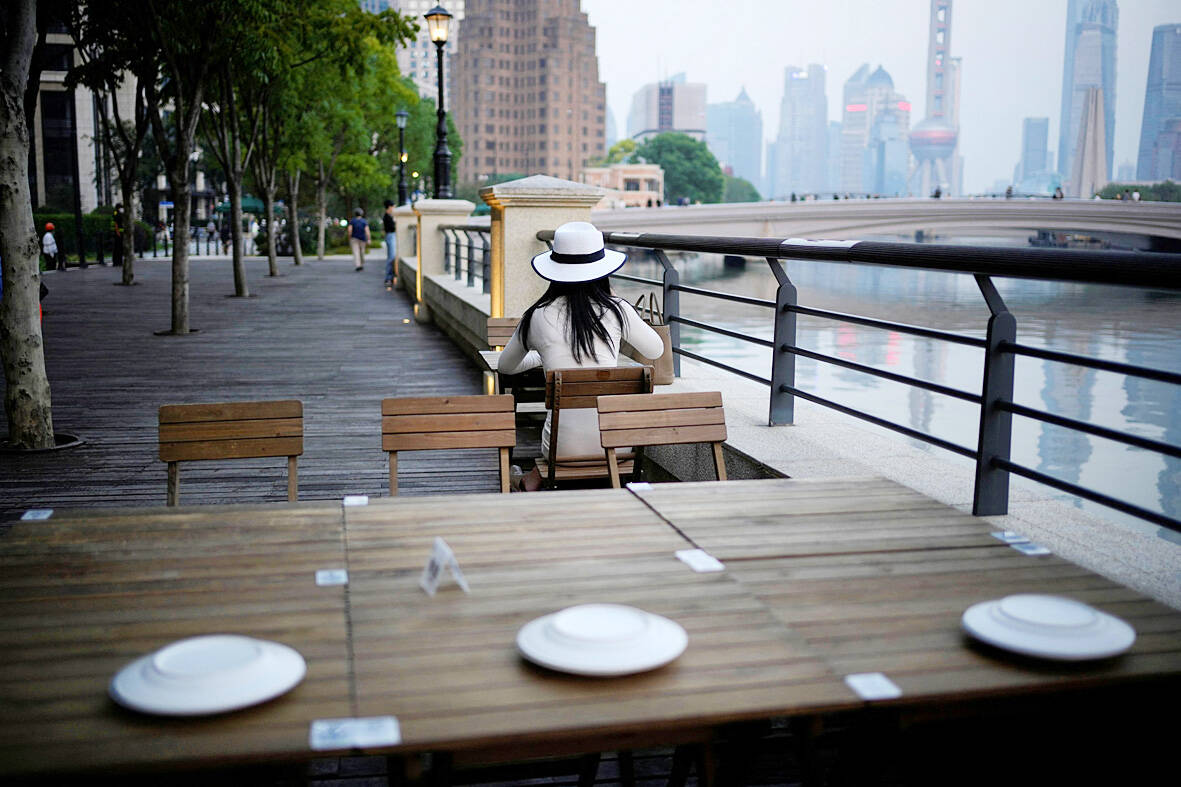Before the pandemic, Doris Fu imagined a different future for herself and her family: new car, bigger apartment, fine dining on weekends and holidays on tropical islands.
Instead, the 39-year old Shanghai marketing consultant is one of many Chinese in their 20s and 30s cutting spending and saving cash where they can, rattled by China’s coronavirus lockdowns, high youth unemployment and a faltering property market.
“I no longer have manicures, I don’t get my hair done anymore. I have gone to China-made for all my cosmetics,” Fu said.

Photo: Reuters
This new frugality, amplified by social media influencers touting low-cost lifestyles and sharing money-saving tips, is a threat to the world’s second-largest economy, which narrowly avoided contraction in the second quarter. Consumer spending accounts for more than half of China’s GDP.
“We’ve been mapping consumer behavior here for 16 years and in all of that time this is the most concerned that I’ve seen young consumers,” said Benjamin Cavender, managing director of China Market Research Group (CMR).
China’s ‘zero-COVID’ policy — including stringent lockdowns, travel restrictions and mass testing — has taken a heavy toll on the country’s economy. The government’s crackdown on big technology companies has also had an outsized effect on the young workforce.

Photo: Reuters
Unemployment among people aged 16 to 24 stands at almost 19 percent, after hitting a record 20 percent in July, according to government data. Some young people have been forced to take pay cuts, for example in the retail and e-commerce sectors, according to two industry surveys. The average salary in 38 major Chinese cities fell 1 percent in the first three months of this year, data collated by online recruitment firm Zhilian Zhaopin show.
As a result, some young people prefer to save than splurge.
“I used to go see two movies every month, but I haven’t stepped inside a cinema since the pandemic,” said Fu, an avid movie fan.
Retail sales in China rose just 2.7 percent year-on-year in July, recovering to 5.4 percent in August but still well below the mostly 7 percent-plus levels during 2019, before the pandemic.
Almost 60 percent of people are now inclined to save more, rather than consume or invest more, according to the most recent quarterly survey by the People’s Bank of China (PBOC), China’s central bank. That figure was 45 percent three years ago.
Chinese households overall added 10.8 trillion yuan (US$1.54 trillion) in new bank savings in the first eight months of the year, up from 6.4 trillion yuan in the same period last year.
That is a problem for China’s economic policymakers, who have long relied on increased consumption to bolster growth.
China is the only leading economy that cut interest rates this year, in an effort to spur growth. China’s big state-owned banks cut personal deposit rates on Sept. 15, a move designed to discourage saving and boost consumption.
Addressing the rise in people’s inclination to save, a PBOC official said in July that when the pandemic eases, the willingness to invest and consume will “stabilize and rise.”
The PBOC did not respond to Reuters requests for comment; neither did China’s Ministry of Commerce.
‘10 YUAN DINNER’
After years of increasingly ardent consumerism fueled by rising wages, easy credit and online shopping, a move toward frugality brings young people in China closer to their more cautious parents, whose memories of lean years before the economy took off have made them more inclined to save.
“Amid the tough job market and strong downward economic pressure, young people’s feelings of insecurity and uncertainty are something they never experienced,” said Zhiwu Chen, chair professor of finance at Hong Kong University Business School.
Unlike their parents, some are making a show of their thriftiness online.
A woman in her 20s in the eastern city of Hangzhou, who uses the handle Lajiang, has gained hundreds of thousands of followers posting more than 100 videos on how to make 10 yuan (US$1.45) dinners on lifestyle app Xiaohongshu and streaming site Bilibili.
In one minute-long video with nearly 400,000 views, she stir-fries a dish made from a 4-yuan basa fillet, 5 yuan of frozen shrimp and 2 yuan of vegetables, using a pink chopping board and pink rice cooker.
Social media discussions have sprung up to share money-saving tips, such as the “Live off 1,600 yuan a month challenge,” in Shanghai, one of China’s most expensive cities.
Yang Jun, who said she was deep in credit card debt before the pandemic, started a group called the Low Consumption Research Institute on networking site Douban in 2019. The group has attracted more than 150,000 members. Yang said she is cutting spending and is selling some of her belongings on second-hand sites to raise cash.
“COVID-19 makes people pessimistic,” the 28-year-old said. “You can’t just be like before, spend all the money you make, and make it back again next month.” She said she is now out of debt.
Yang said she has cut out her daily Starbucks coffee. Fu said she switched her makeup powder brand from Givenchy to a Chinese brand called Florasis, which is about 60 percent cheaper.
French luxury brands leader LVMH, which owns Givenchy, and coffee giant Starbucks Corp both said sales fell sharply in China in the latest quarter.
China has given no signal on when or how it will exit from its zero-COVID policy. And while policymakers have taken various measures in hopes of boosting consumption, from subsidies for car buyers to shopping vouchers, far more money and attention has been directed towards infrastructure as a way of stimulating the economy.
Stability has been the key theme for China’s policymakers this year, experts say, as President Xi Jinping gears up for a third leadership term at next month’s congress of the ruling Communist Party.
“In the past, when you had economic slowdown, consumers were more likely to feel that government policy is going to fix this problem very quickly,” said Cavender at CMR. “I think right now the challenge is when you interview younger consumers they really don’t know what the future holds.”
Fu, the marketing professional, said she has deferred plans to sell her two small apartments to buy a bigger one in a better school district for her son, and has given up for now on upgrading from her Volkswagen Golf.
“Why do I dare not upgrade my house and my car, even if I have the money?” she said. “Everything is unknown.”

This is the year that the demographic crisis will begin to impact people’s lives. This will create pressures on treatment and hiring of foreigners. Regardless of whatever technological breakthroughs happen, the real value will come from digesting and productively applying existing technologies in new and creative ways. INTRODUCING BASIC SERVICES BREAKDOWNS At some point soon, we will begin to witness a breakdown in basic services. Initially, it will be limited and sporadic, but the frequency and newsworthiness of the incidents will only continue to accelerate dramatically in the coming years. Here in central Taiwan, many basic services are severely understaffed, and

Jan. 5 to Jan. 11 Of the more than 3,000km of sugar railway that once criss-crossed central and southern Taiwan, just 16.1km remain in operation today. By the time Dafydd Fell began photographing the network in earnest in 1994, it was already well past its heyday. The system had been significantly cut back, leaving behind abandoned stations, rusting rolling stock and crumbling facilities. This reduction continued during the five years of his documentation, adding urgency to his task. As passenger services had already ceased by then, Fell had to wait for the sugarcane harvest season each year, which typically ran from

It is a soulful folk song, filled with feeling and history: A love-stricken young man tells God about his hopes and dreams of happiness. Generations of Uighurs, the Turkic ethnic minority in China’s Xinjiang region, have played it at parties and weddings. But today, if they download it, play it or share it online, they risk ending up in prison. Besh pede, a popular Uighur folk ballad, is among dozens of Uighur-language songs that have been deemed “problematic” by Xinjiang authorities, according to a recording of a meeting held by police and other local officials in the historic city of Kashgar in

It’s a good thing that 2025 is over. Yes, I fully expect we will look back on the year with nostalgia, once we have experienced this year and 2027. Traditionally at New Years much discourse is devoted to discussing what happened the previous year. Let’s have a look at what didn’t happen. Many bad things did not happen. The People’s Republic of China (PRC) did not attack Taiwan. We didn’t have a massive, destructive earthquake or drought. We didn’t have a major human pandemic. No widespread unemployment or other destructive social events. Nothing serious was done about Taiwan’s swelling birth rate catastrophe.